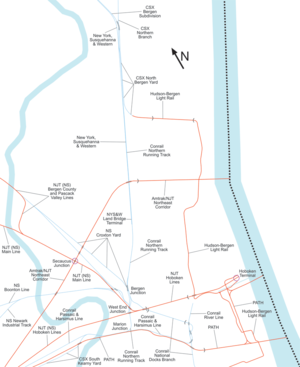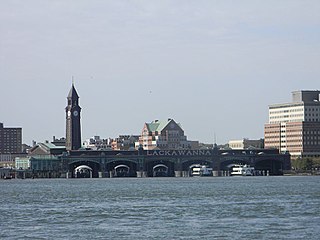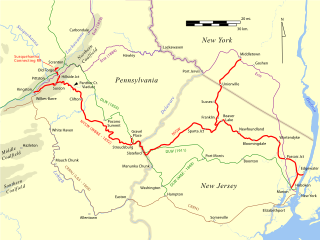




Bergen Arches is an abandoned railroad right of way through Bergen Hill (the lower New Jersey Palisades) in Jersey City, New Jersey.





Bergen Arches is an abandoned railroad right of way through Bergen Hill (the lower New Jersey Palisades) in Jersey City, New Jersey.
Bergen Arches is the common name for the Erie Cut, the Erie Railroad's mile-long, four-track cut which linked the railroad's main line to its Hudson River waterfront Pavonia Terminal, where travelers to Manhattan could transfer to the Pavonia Ferry or the Hudson and Manhattan Railroad. [1] From 1906 to 1910, [2] using 250,000 pounds of dynamite, workers blasted through 800,000 cubic yards (610,000 m3) of blue trap rock; 160,000 cubic yards (120,000 m3) of earth were excavated. There were construction cost overruns (and settlements paid to local homeowners for damage and injuries from flying rock), with a total cost around $5 million, that led to financial trouble for the Erie and the cancellation of plans to build a new terminal along the Jersey City waterfront. [3] The term "Bergen Arches" originally referred to the massive bridges over the cut, but the two terms have become synonymous.
The last trains to the terminal ran in 1957. The line was abandoned that year. The adjacent tunnel (the Long Dock Tunnel) from the mid-19th century that the Erie Cut replaced is used for freight, and is being restored as part of Liberty Corridor Project as an extension of National Docks Secondary line.
Various projects have been proposed for the abandoned track bed: for a four-lane or six-lane highway that would connect the New Jersey Turnpike and U.S. Route 1/9 bypassing traffic headed along New Jersey Route 139 for the Holland Tunnel, [4] extension of the Hudson Bergen Light Rail, or in conjunction with the Harsimus Stem Embankment, a recreational greenway.
A freeway proposed in 1989 by Governor Thomas Kean [5] was strongly supported by then-Mayor Bret Schundler. In 1998, this project was allocated $26 million in the federal Transportation Equity Act for the 21st Century. [6] [7] During the 2001 mayoral race, candidates instead lobbied for a mass transit line, [8] and in 2002 the plans were dropped during Mayor Cunningham's administration. [9] In that year, Parsons Brinckerhoff, a consulting firm, released another report commissioned by New Jersey Department of Transportation (NJDOT) and describing the conditions and analyzing of various options. [10] [11] NJDOT has continued to fund studies for the project. In March 2011, an additional $13.4 million was allocated to advance the project. [12]
A Bergen Arches Preservation Coalition has proposed to run the East Coast Greenway through the Arches. [13] [14]

Route 139 is a state highway in Jersey City, New Jersey in the United States that heads east from the Pulaski Skyway over Tonnele Circle to the state line with New Jersey and New York in the Holland Tunnel, which is under the Hudson River, to New York City. The western portion of the route is a two level highway that is charted by the New Jersey Department of Transportation as two separate roadways: The 1.45-mile (2.33 km) lower roadway (Route 139) between U.S. Route 1/9 (US 1/9) over Tonnele Circle and Interstate 78 (I-78) at Jersey Avenue, and the 0.83-mile (1.34 km) upper roadway running from County Route 501 and ending where it joins the lower highway as part of the 12th Street Viaduct, which ends at Jersey Avenue. The lower roadway is listed on the federal and NJ state registers of historic places since 2005. The eastern 1.32 miles (2.12 km) of the route includes the Holland Tunnel approach that runs concurrent with Interstate 78 on the one-way pair of 12th Street eastbound and 14th Street westbound. Including the concurrency, the total length of Route 139 is 2.77 miles (4.46 km).

The Hudson–Bergen Light Rail (HBLR) is a light rail system in Hudson County, New Jersey, United States. Owned by New Jersey Transit (NJT) and operated by the 21st Century Rail Corporation, it connects the communities of Bayonne, Jersey City, Hoboken, Weehawken, Union City, and North Bergen.

The Main Line is a commuter rail line owned and operated by New Jersey Transit running from Suffern, New York to Hoboken, New Jersey, in the United States. It runs daily commuter service and was once the north–south main line of the Erie Railroad. It is colored yellow on NJ Transit system maps, and its symbol is a water wheel.

Hoboken Terminal is a commuter-oriented intermodal passenger station in Hoboken, Hudson County, New Jersey. One of the New York metropolitan area's major transportation hubs, it is served by nine NJ Transit (NJT) commuter rail lines, one Metro-North Railroad line, various NJT buses and private bus lines, the Hudson–Bergen Light Rail, the Port Authority Trans Hudson (PATH) rapid transit system, and NY Waterway-operated ferries.

For the purposes of this article, the Jersey City area extends North to Edgewater, South to Bayonne and includes Kearny Junction and Harrison but not Newark. Many routes east of Newark are listed here.

The New Jersey Midland Railway was a 19th-century predecessor to the New York, Susquehanna and Western Railway (NYS&W) that operated in Northern New Jersey and Orange County, New York.

The Newport station is a station on the PATH system. Located on Town Square Place at the corner of Washington Boulevard in the Newport neighborhood of Jersey City, New Jersey, it is served by the Hoboken–World Trade Center and Journal Square–33rd Street lines on weekdays, and by the Journal Square–33rd Street line on weekends. As of 2017, its estimated weekday use was nearly 20,000 passengers, up from 17,000 to 18,000 average weekday passengers in 2010.

The Central Railroad of New Jersey Terminal, also known as Communipaw Terminal and Jersey City Terminal, was the Central Railroad of New Jersey's waterfront passenger terminal in Jersey City, New Jersey. The terminal was built in 1889, replacing an earlier one that had been in use since 1864. It operated until April 30, 1967.

Pavonia Terminal was the Erie Railroad terminal on the Hudson River situated on the landfilled Harsimus Cove in Jersey City, New Jersey. The station opened in 1861 and closed in 1958 when the Erie Railroad moved its passenger services to nearby Hoboken Terminal. The New York, Susquehanna and Western Railway also ran commuter trains from the terminal and various street cars, ferries and the underground Hudson and Manhattan Railroad serviced the station. The station was abandoned in 1958 and demolished in 1961. The site was eventually redeveloped into the Newport district in the late 20th century.

Bergen Hill refers to the lower Hudson Palisades in New Jersey, where they emerge on Bergen Neck, which in turn is the peninsula between the Hackensack and Hudson Rivers, and their bays. In Hudson County, it reaches a height of 260 feet.

The Hudson River Waterfront Walkway, also known as the Hudson River Walkway, is a promenade along the Hudson Waterfront in New Jersey. The ongoing and incomplete project located on Kill van Kull and the western shore of Upper New York Bay and the Hudson River was implemented as part of a New Jersey state-mandated master plan to connect the municipalities from the Bayonne Bridge to the George Washington Bridge with an urban linear park and provide contiguous unhindered access to the water's edge.

The Passaic–Bergen–Hudson Transit Project is a project under study by NJ Transit to reintroduce passenger service on a portion of the New York, Susquehanna and Western Railway (NYSW) right-of-way (ROW) in Passaic, Bergen and Hudson counties using newly built, FRA-compliant diesel multiple unit rail cars. Plans call for service to run from Hawthorne south through Paterson, east to Hackensack and then southeast to North Bergen, where it would join the Hudson-Bergen Light Rail (HBLR).

Weehawken Terminal was the waterfront intermodal terminal on the North River in Weehawken, New Jersey for the New York Central Railroad's West Shore Railroad division, whose route traveled along the west shore of the Hudson River. It opened in 1884 and closed in 1959. The complex contained five ferry slips, sixteen passenger train tracks, car float facilities, and extensive yards. The facility was also used by the New York, Ontario and Western Railway. The terminal was one of five passenger railroad terminals that lined the Hudson Waterfront during the 19th and 20th centuries; the others were located at Hoboken, Pavonia, Exchange Place and Communipaw, with Hoboken being the only one still in use.

WR Draw is an out-of-service railroad bridge crossing the Passaic River between Newark and the Arlington section of Kearny, New Jersey. The plate girder rim-bearing swing bridge, originally built in 1897 and modified in 1911 and 1950, is the 14th bridge from the river's mouth at Newark Bay and is 8.1 miles (13.0 km) upstream from it. Last used for regular passenger service in 2002, it is welded in closed position as its height is not considered a hazard to navigation.
The Newark Branch was a branch of the Erie Railroad in New Jersey, United States, running between Jersey City and Paterson and passing through the Broadway Section in North Newark, the origin of its name. Inaugurated in the 1870s, the line was last used for passenger service on September 30, 1966 but continues to be used for freight service on a portion of its length.

The Newark Drawbridge, also known as the Morristown Line Bridge, is a railroad bridge on the Passaic River between Newark and Harrison, New Jersey. The swing bridge is the 11th bridge from the river's mouth at Newark Bay and is 5.85 miles (9.41 km) upstream from it. Opened in 1903, it is owned and operated by New Jersey Transit.

The Edgewater Branch was a branch of the New York, Susquehanna and Western Railway (NYS&W) that ran about 3.174 miles (5.108 km) through eastern Bergen County, New Jersey in the United States. Starting from a rail junction at the Little Ferry Yard, it went east through the Edgewater Tunnel to Undercliff to the Hudson Waterfront.

Ridgefield Park station, also known as West Shore Station, was a railroad station in Ridgefield Park, New Jersey at the foot of Mount Vernon Street served by the New York, Susquehanna and Western Railroad (NYSW) and the West Shore Railroad, a division of New York Central (NYCRR). The New York, Ontario and Western Railway (NYO&W) had running rights along the West Shore and sometimes stopped at Ridgefield Park. First opened in 1872 it was one of three passenger stations in the village, the others being the Little Ferry station to the south and Westview station to the north. Service on the West Shore Railroad began in 1883. The station house, built at a cost $100,000 opened in 1927. Southbound service crossed Overpeck Creek and continued to terminals on the Hudson River waterfront where there was connecting ferry service across the Hudson River to Manhattan. Northbound near Bogota the parallel NYSW and West Shore lines diverge and continue into northern New Jersey, Pennsylvania, and upstate New York. Passenger service ended in 1966.

Hackensack was a railroad station in Hackensack, New Jersey on the New York, Susquehanna and Western Railway Main Line, which provided passenger service between the 1870s and 1960s. The station at Main and Mercer Streets opened in 1872; it was replaced with one at River Street in 1950. Public Service trolley lines served both stations.

North Bergen was a railroad station in North Bergen, New Jersey, United States known Homestead for most of its existence. It as built in the mid 19th century and served by the New York, Susquehanna and Western Railway (#1059) and the Erie Railroad's Northern Branch (#1903).